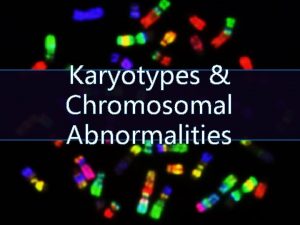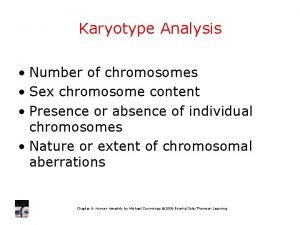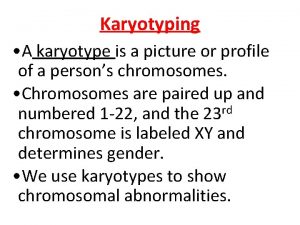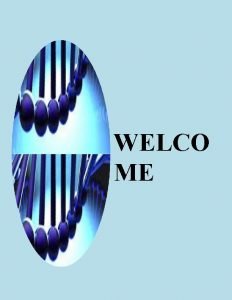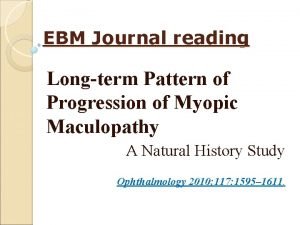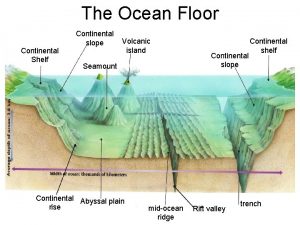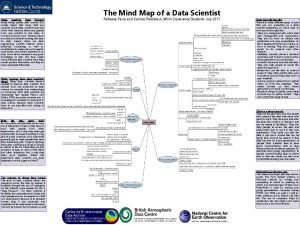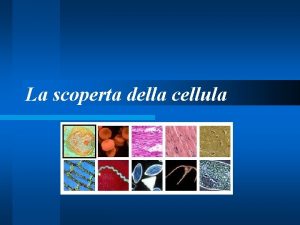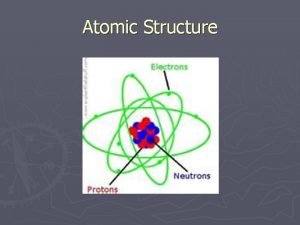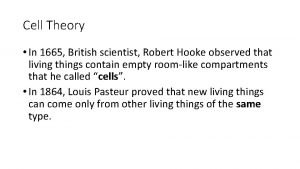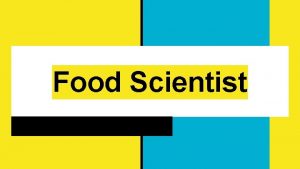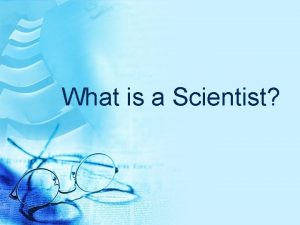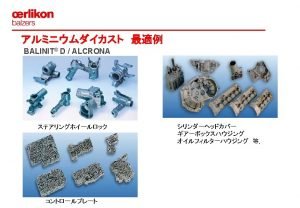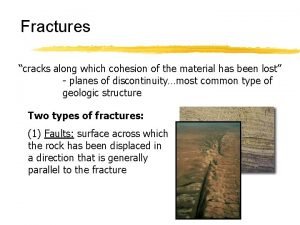Karyotyping Karyotyping is when a scientist cracks open



































- Slides: 35

Karyotyping

• Karyotyping is when a scientist cracks open a nucleus, removes all the chromosomes. • The scientist then lays out all the individuals chromosomes and pairs the homologous pairs in order to learn something about the individuals genetics • So lets first discuss what a chromosome is and what we can learn from them

CHROMOSOMES ARE IN NUCLEUS

CHROMSOMES ARE TIGHTLY WRAPPED DNA

A GENE IS A SEGMENT OF DNA THAT CODES FOR A PARTICULAR TRAIT

REMOVED FROM NUCLEUS

STAINING

• CHROMOSOMES LOOK LIKE Xs if you find them in when the DNA is duplicated (Interphase S phase-Metaphase)

• The rest of the time the chromosomes are singular poles • This is how they will be shown the majority of the time

Human Chromosomes • Humans have 46 chromosomes normally. • 22 autosomes (2 of each) and 2 “sex” chromosomes “Sex Assigned At Birth”- male or female designation made by hospital either by karyotyping or by physical anatomy at birth Female: X___ Male: X__

Human Chromosomes • Humans have 46 chromosomes normally. • 22 autosomes (2 of each) and 2 “sex” chromosomes “Sex Assigned At Birth”- male or female designation made by hospital either by karyotyping or by physical anatomy at birth Female: XX Male: XY

Karyotype • Karyotype- when scientists look at chromosomes and arrange them, and analyze them.

Karyotype • Arranged by size • Arranged by position of centromere • First arrange normal chromosomes • Try to arrange anything irregular

Staining chromosomes • Stain Giemsa Staining stains the A and T rich portion of DNA dark. • Banding patterns depend on genetic code • Banding patterns unique to certain chromosomes

Normal Karyotype 23 homologous pairs 46 chromosomes

• What are the sex chromosomes ?

X and Y

What is determined by sex chromosomes? • SOME TRAITS: sex chromosomes do not carry an identical complement of genetic information. The X chromosome, being larger, carries many more genes than does the Y. Traits controlled by genes found only on the X chromosome are said to be sex-linked. Recessive sex-linked traits, such as hemophilia and red–green color blindness, occur far more frequently in men than in women. This is because the male who inherits the recessive allele on his X chromosome has no allele on his Y chromosome to counteract its effects. • Controls Hormone Production

Chromosomal notation: • 46, XY(chromosomally normal female) • 46, XX(chromosomally normal male) • 47, XX, +21 ABNORMAL EXTRA 21 what’s the disease?

Down Syndrome 3 chromosomes (21 st pair)

Down Syndrome Traits • mental retardation • epicanthal folds over eyes • flattened bridge of the nose

When Meiosis Fails

Normal Meiosis: produces 4 genetically different sex cells but same chromosome number

Nondisjunction An uneven splitting of the chromosomes during meiosis

Nondisjuction Animation

Down Syndrome Karyotype 3 chromosome s st (21 pair)

Down Syndrome Traits • mental retardation • epicanthal folds over eyes • flattened bridge of the nose

Nondisjunction in Sex Chromosomes

Turner Syndrom e: Missing X

Turner Syndrome Symptoms • short stature • sterile • webbed neck • skeletal disorders

XYY Syndrome • Falsely called “superman” or “criminal” syndrome. • 5 -10 born each day in USA

XYY Symptoms • taller • more hairy • heavy facial features • delays in learning & language • violent tendencies ? ?


Klinefelter Syndrome: XXY

Klinefelter Symptoms • underdeveloped male traits • mammary development • learning disabilities • language delays • infertility
 Karyotyping
Karyotyping Karyotyping
Karyotyping Trisomy examples
Trisomy examples Karyotype of klinefelter syndrome
Karyotype of klinefelter syndrome Karyotyping
Karyotyping X chromosome example
X chromosome example A scientist's open-mindedness should always be balanced by
A scientist's open-mindedness should always be balanced by 영국 beis
영국 beis Mud cracks
Mud cracks Skin cracks like a pod
Skin cracks like a pod Cracks in rocks widen as water in them freezes and thaws
Cracks in rocks widen as water in them freezes and thaws Angioid streaks vs lacquer cracks
Angioid streaks vs lacquer cracks Flexural shear cracks
Flexural shear cracks Zipper cracks in rolling
Zipper cracks in rolling To a daughter leaving home and poem for my sister
To a daughter leaving home and poem for my sister Lacquer cracks eyewiki
Lacquer cracks eyewiki Planar cross bedding
Planar cross bedding Continental margins
Continental margins As cannons overcharged with double cracks meaning
As cannons overcharged with double cracks meaning Mind map data science
Mind map data science Christ the scientist
Christ the scientist La scoperta della cellula
La scoperta della cellula What scientist discovered the electron
What scientist discovered the electron Ofcom data scientist
Ofcom data scientist Who was the most famous scientist of the hellenistic era
Who was the most famous scientist of the hellenistic era Sam fraiberger
Sam fraiberger A scientist planted seeds in 4 sections
A scientist planted seeds in 4 sections Mad scientist club book
Mad scientist club book What makes a scientist
What makes a scientist Endoplasmic reticulum work
Endoplasmic reticulum work Data science ausbildung wien
Data science ausbildung wien Which scientist
Which scientist Functions of a forensic scientist
Functions of a forensic scientist Girl scout volunteer toolkit
Girl scout volunteer toolkit Mark dean computer scientist
Mark dean computer scientist Avogadro scientist
Avogadro scientist
